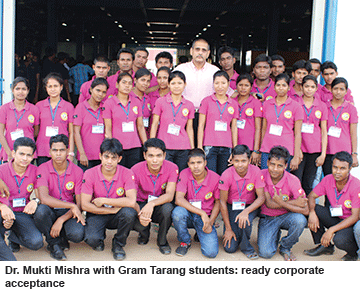Centurion University’s Gram Tarang initiative has provided employment-yielding vocational training to 40,000 rural youth in the insurgency-infected Red Corridor districts of Odisha
 In 2006, a team of professional educationists comprising professors Dr. Mukti Kanta Mishra, D.N. Rao and D. Nageshwara Rao took over the Jagannath Institute for Technology and Management, a failing engineering college in Parlakhemundi, Gajapati — the poorest and heavily Maoist insurgency-affected district of the eastern seaboard state of Odisha (formerly Orissa, pop.40 million). Inspired by the turnaround of the college, the team established another campus in Bhubaneswar. After the state government passed enabling legislation in 2010, the two enterprises were merged under the name and style of the Centurion University of Technology & Management (CUTM). The ambitious objective of CUTM is “building human resource capability, resulting in employability as well as entrepreneurship development across disadvantaged areas of the world”.
In 2006, a team of professional educationists comprising professors Dr. Mukti Kanta Mishra, D.N. Rao and D. Nageshwara Rao took over the Jagannath Institute for Technology and Management, a failing engineering college in Parlakhemundi, Gajapati — the poorest and heavily Maoist insurgency-affected district of the eastern seaboard state of Odisha (formerly Orissa, pop.40 million). Inspired by the turnaround of the college, the team established another campus in Bhubaneswar. After the state government passed enabling legislation in 2010, the two enterprises were merged under the name and style of the Centurion University of Technology & Management (CUTM). The ambitious objective of CUTM is “building human resource capability, resulting in employability as well as entrepreneurship development across disadvantaged areas of the world”.
Since then, the varsity’s management led by Dr. Mishra has quickly established eight faculties/schools (engineering and technology, agriculture sciences, basic sciences, business management, humanities, and vocational and distance education studies). Currently the university has an aggregate enrollment of 15,000 students (including 7,000 women) mentored by a faculty aggregating 324 and over 300 lab instructors.
Although in essence, CUTM is a professional education degrees-awarding university with clear intent to prepare students for white collar jobs in industry, it also hosts a School of Vocation which offers certificate courses and diploma programmes for learning blue-collar industry-oriented skills (fitter, welder, electrician, CNC operator, auto service technician etc). All programmes are industry approved with the university guaranteeing job placements. Currently the school has seven learning/training centres in Odisha, four in neighbouring (former) Andhra Pradesh, one in Jharkhand and two in Assam.
Moreover, to provide vocational education and training (VET ) to rural youth in the desperately poor and Maoist insurgency infected Red Corridor districts of Odisha, in 2010, CUTM promoted its Gram Tarang Employability Training Services initiative in collaboration with the National Skill Development Corporation (NSDC) and the Central and state governments. Since then, 30,000 rural youth — mostly school dropouts — have been trained and certified as machinists, fitters, welders, electricians, plumbers, mechanics and retail assistants in CUTM-Gram Tarang satellite training centres. CUTM has also trained and placed an additional 10,000 below poverty line rural youth under the Union ministry of rural development’s Swaranjayanti Gram Swarozgar Yojana (SGSY) programme.
“I am pleased to inform readers of EducationWorld that of the 40,000 rural youth trained under Gram Tarang and the rural development ministry’s SGSY programmes during the past four years, 84 percent have been placed in jobs paying start-up salaries of Rs.6,500-8,500 per month. Among the companies which have readily accepted Gram Tarang certified youth are Café Coffee Day, Cotton Blossom Textiles (Bangalore), Samsung, Tata ASLAP (Pune), Ashok Leyland, Tata Motors and Graziano (Noida). Reports indicate their career progression is excellent and some Gram Tarang programme graduates are earning Rs.20,000 per month,” says Mishra.
Despite the positive socio-economic outcomes of the CUTM-Gram Tarang rural youth skilling initiative, given the gigantic scale of India’s youth unemployment, and under-employment problem, Mishra is less than satisfied with the pace of progress in the number of youth being skilled and trained annually. According to him there is “irrational exuberance” and obsession in government and NSDC with numbers.
“While the Central government and NSDC have set a target to provide VET and certification to 500 million youth by 2020, they aren’t paying adequate attention to building the support systems required to attain these ambitious targets. For one, the freebies or free handouts policies of the Union and state governments — MNREGA, Food Security Act, etc — are creating learning and migration resistance in rural areas. Moreover there is an acute shortage of quality infrastructure with many of the existing centres having archaic equipment. Somehow no one is talking about quality of training and competencies developed,” says Mishra.
This is valuable advice. India has awoken late to the VET revolution which has transformed the economies of several newly-emergent industrial heavyweights such as China and South Korea, which have rapidly metamorphosed from agri commodities exporters into industrial and manufacturing hubs commanding global respect. But in the haste to catch up, India’s ambitious vocational education institutions must ensure they don’t repeat the past experience of sacrificing quality for quantity.